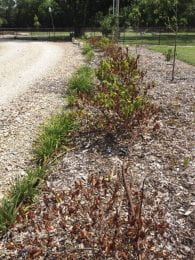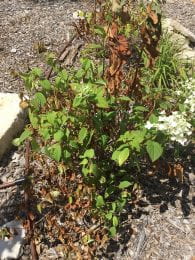Wet then Hot….Hydrangea shrubs crash and burn
By: Judy O’Mara
At first glance, the declining hydrangea makes you think that they were wiped out by a disease. A quick check of the very useful K-State website (http://mesonet.k-state.edu/weather/historical) for historical weather data for Morris County (where hydrangea plants were grown) shows that it got 27.83″ of rain in the first half of the year (January 1 -July 7, 2019). Of that amount, almost 23″ (22.95”) of rain was received during April 29 –July 7th with several periods of 4-6″ over that ten week period. Basically that is a lot of rain.


The impact here is that lots of rain can keep soils wet and soggy, which in turn damages the root system. Plants with damaged roots may not have expressed symptoms during May or June because temperatures during that period were fairly moderate. More recently temps jumped into the 90s and damaged root system were unable to support the tops of the plant. Affected Hydrangeas crashed and burned. Mulch is generally a useful tool to help suppress weeds and keeps soils moist. Too much mulch over heavy clay soils can aggravate the problem by keeping soils too wet. It can be very hard to regrow damaged root systems so, recovery potential for these plants isn’t very good.
Rhizoctonia Root Rot on Coreopsis
 Many plants with poor growth this summer have been suffering due to saturated soils and high temperatures. However, sometimes plant decline is due to a disease. This Coreopsis bed sustained damage from a fungal disease called Rhizoctonia crown and root rot. The disease can survive in the soil for long periods and is triggered by high temperatures and moist soils. Long-term the best management option is to start over with new Coreopsis plants in a new location.
Many plants with poor growth this summer have been suffering due to saturated soils and high temperatures. However, sometimes plant decline is due to a disease. This Coreopsis bed sustained damage from a fungal disease called Rhizoctonia crown and root rot. The disease can survive in the soil for long periods and is triggered by high temperatures and moist soils. Long-term the best management option is to start over with new Coreopsis plants in a new location.